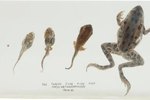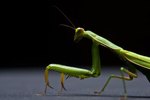
Walking stick bugs are long, thin members of the insect family Phasmatidae. They resemble sticks or twigs, which give them natural camouflage and an effective passive defense against predators. Walking sticks are found in ecosystems worldwide, in tropical, temperate and subtropical climatic zones. They are herbivorous insects. According to "National Geographic," about 3,000 species exist, ranging in size, color and shape. Life span varies among species from several months to 2 years.
Eggs
In general, the female will lay in excess of 100 eggs, some species laying more than 1,000 eggs per gestation. The insect can lay the eggs in the soil or into hollow parts of plants, attach them to the different plant parts or drop them on the ground. These eggs resemble seeds -- they are small, oval and hard-shelled. Eggs dropped to the ground have large capitula that contain substances ants feed on. When ants find these eggs, they normally carry them to their nest and feed on the capitula without destroying the embryo. Eggs in the ant nest are thus protected against predators, and they hatch safely. This adaptation protects eggs from winter; they hatch when the weather warms up in spring. Eggs can hatch after a period of few weeks to several months, depending on species and habitat.
Nymph
Nymphs resemble adults but differ in color and size. Nymphs grow by molting, a process in which they shed their outer skins as they increase in size. The stick insects normally feed on their own leftover skins after they shed them. Depending on species and sex, nymphs molt on average between four and eight times before maturity. To escape predators, nymphs are able to shed off limbs -- autotomy -- and regenerate them during the molting process. This ability lasts only until maturity.
Adulthood
Walking stick bugs reach maturity after 3 months to a year. Female stick bugs are generally larger than males. This is due to their large abdomens for production of eggs and larger mouths to consume more food. Most male stick species have wings that enable them to fly in search of mates. In addition to camouflage, different adult stick insects species have other adaptations that enable them to escape predators. They include playing dead for long hours, swiping predators with spines on their legs and emitting an irritating, foul-smelling liquid.
Mating and Reproduction
Due to the rarity of male walking stick bugs, these species reproduce through parthenogenesis -- a process in which unfertilized eggs develop individually. This means that external eggs fertilization by the males is not a necessity for reproduction to continue. Unfertilized eggs hatch to resemble the females that produced them. Nonetheless, some males exist and mate with the females. During mating, a male and female will remain coupled together for several hours, days or even weeks.
References
Photo Credits
-
Jupiterimages/Photos.com/Getty Images
Writer Bio
Kendal Elizabeth has been a professional writer and editor since 2001. She has specialized in writing pet-related topics, home decor and gardening. Her work has appeared on several online and offline publication. Elizabeth holds a Bachelor of Science in Animal Science with a minor in marine biology from Cornell University.




